Effects of a Protocol Combining a Non-Irritating Shampoo and an Adelmidrol-Based Adsorbent Mousse on Seborrhoea and Other Signs and Symptoms Secondary to Canine Atopic Dermatitis: A Multicenter, Open-Label Uncontrolled Clinical Trial
Abstract
Simple Summary
Abstract
1. Introduction
2. Materials and Methods
2.1. Enrollment Criteria
2.2. Design of the Study
2.3. Investigator and Owner Satisfaction
2.4. Statistical Methods
3. Results
3.1. Dog Population
3.2. Clinical Presentation
3.2.1. Seborrhoea
3.2.2. Pruritus
3.2.3. Skin Lesions
3.2.4. Cytology
3.3. Clinical Evolution
3.3.1. Seborrhoea
3.3.2. Pruritus
3.3.3. Skin Lesions
3.3.4. Cytology
3.4. Investigator and Owner Satisfaction
4. Discussion
5. Conclusions
Supplementary Materials
Author Contributions
Funding
Institutional Review Board Statement
Informed Consent Statement
Data Availability Statement
Acknowledgments
Conflicts of Interest
References
- Olivry, T.; DeBoer, D.J.; Favrot, C.; Jackson, H.A.; Mueller, R.S.; Nuttall, T.; Prélaud, P.; for the International Committee on Allergic Diseases of Animals. Treatment of Canine Atopic Dermatitis: 2015 Updated Guidelines from the International Committee on Allergic Diseases of Animals (ICADA). BMC Vet. Res. 2015, 11, 210. [Google Scholar] [CrossRef]
- Bizikova, P.; Pucheu-Haston, C.M.; Eisenschenk, M.N.C.; Marsella, R.; Nuttall, T.; Santoro, D. Review: Role of Genetics and the Environment in the Pathogenesis of Canine Atopic Dermatitis. Vet. Dermatol. 2015, 26, 95-e26. [Google Scholar] [CrossRef] [PubMed]
- Marsella, R.; Sousa, C.A.; Gonzales, A.J.; Fadok, V.A. Current Understanding of the Pathophysiologic Mechanisms of Canine Atopic Dermatitis. J. Am. Vet. Med. Assoc. 2012, 241, 194–207. [Google Scholar] [CrossRef] [PubMed]
- Eisenschenk, M. Phenotypes of Canine Atopic Dermatitis. Curr. Derm. Rep. 2020, 9, 175–180. [Google Scholar] [CrossRef]
- Hensel, P.; Saridomichelakis, M.; Eisenschenk, M.; Tamamoto-Mochizuki, C.; Pucheu-Haston, C.; Santoro, D.; for the International Committee on Allergic Diseases of Animals (ICADA). Update on the Role of Genetic Factors, Environmental Factors and Allergens in Canine Atopic Dermatitis. Vet. Dermatol. 2024, 35, 15–24. [Google Scholar] [CrossRef] [PubMed]
- Santoro, D.; Saridomichelakis, M.; Eisenschenk, M.; Tamamoto-Mochizuki, C.; Hensel, P.; Pucheu-Haston, C.; for the International Committee on Allergic Diseases of Animals (ICADA). Update on the Skin Barrier, Cutaneous Microbiome and Host Defence Peptides in Canine Atopic Dermatitis. Vet. Dermatol. 2024, 35, 5–14. [Google Scholar] [CrossRef] [PubMed]
- Bond, R.; Morris, D.O.; Guillot, J.; Bensignor, E.J.; Robson, D.; Mason, K.V.; Kano, R.; Hill, P.B. Biology, Diagnosis and Treatment of Malassezia Dermatitis in Dogs and Cats Clinical Consensus Guidelines of the World Association for Veterinary Dermatology. Vet. Dermatol. 2020, 31, 27. [Google Scholar] [CrossRef]
- Marsella, R. Advances in Our Understanding of Canine Atopic Dermatitis. Vet. Dermatol. 2021, 32, 547. [Google Scholar] [CrossRef] [PubMed]
- Santoro, D. Therapies in Canine Atopic Dermatitis. Vet. Clin. N. Am. 2019, 49, 9–26. [Google Scholar] [CrossRef]
- Kondratjeva, J.; Brun, J.; Amalric, N.; Moog, F.; Combarros, D.; Pressanti, C.; Zemirline, C.; Maubert, N.; Ollivier, E.; Gatellet, M.; et al. Performance and Tolerance of a Protocol for Idiopathic Chronic Greasy Seborrhea in 18 Dogs Using a Shampoo and Mousse Containing Plant Extracts. Vet. Sci. 2023, 10, 95. [Google Scholar] [CrossRef]
- Nuttall, T. Topical Therapy in Canine Atopic Dermatitis: New Products. Companion Anim. 2020, 25, 76–82. [Google Scholar] [CrossRef]
- Barba, C.; Semenzato, A.; Baratto, G.; Coderch Negra, M.L. Action of Surfactants on the Mammal Epidermal Skin Barrier. G. Ital. Dermatol. Venereol. 2019, 154, 405–412. [Google Scholar] [CrossRef] [PubMed]
- Linek, M.; Favrot, C. Impact of Canine Atopic Dermatitis on the Health-Related Quality of Life of Affected Dogs and Quality of Life of Their Owners: Atopic Dermatitis and Quality of Life. Vet. Dermatol. 2010, 21, 456–462. [Google Scholar] [CrossRef] [PubMed]
- Noli, C.; Colombo, S.; Cornegliani, L.; Ghibaudo, G.; Persico, P.; Vercelli, A.; Galzerano, M. Quality of Life of Dogs with Skin Disease and of Their Owners. Part 2: Administration of a Questionnaire in Various Skin Diseases and Correlation to Efficacy of Therapy: Quality of Life Assessment. Vet. Dermatol. 2011, 22, 344–351. [Google Scholar] [CrossRef] [PubMed]
- van Amersfort, K.; van der Lee, A.; Hagen-Plantinga, E. Evidence-base for the Beneficial Effect of Nutraceuticals in Canine Dermatological Immune-mediated Inflammatory Diseases—A Literature Review. Vet. Dermatol. 2023, 34, 266–283. [Google Scholar] [CrossRef] [PubMed]
- Miragliotta, V.; Noli, C. Dermatology: Endocannabinoids and Related N-Acylethanolamines in the Skin. In Cannabis Therapy in Veterinary Medicine; Cital, S., Kramer, K., Hughston, L., Gaynor, J.S., Eds.; Springer International Publishing: Cham, Switzerland, 2021; pp. 207–230. ISBN 978-3-030-68316-0. [Google Scholar]
- Abramo, F.; Campora, L.; Albanese, F.; Della Valle, M.F.; Cristino, L.; Petrosino, S.; Di Marzo, V.; Miragliotta, V. Increased Levels of Palmitoylethanolamide and Other Bioactive Lipid Mediators and Enhanced Local Mast Cell Proliferation in Canine Atopic Dermatitis. BMC Vet. Res. 2014, 10, 21. [Google Scholar] [CrossRef] [PubMed]
- Campora, L.; Miragliotta, V.; Ricci, E.; Cristino, L.; Di Marzo, V.; Albanese, F.; Federica Della Valle, M.; Abramo, F. Cannabinoid Receptor Type 1 and 2 Expression in the Skin of Healthy Dogs and Dogs with Atopic Dermatitis. Am. J. Vet. Res. 2012, 73, 988–995. [Google Scholar] [CrossRef] [PubMed]
- Cerrato, S.; Brazis, P.; Della Valle, M.F.; Miolo, A.; Petrosino, S.; Marzo, V.D.; Puigdemont, A. Effects of Palmitoylethanolamide on the Cutaneous Allergic Inflammatory Response in Ascaris Hypersensitive Beagle Dogs. Vet. J. 2012, 191, 377–382. [Google Scholar] [CrossRef] [PubMed]
- Noli, C.; Della Valle, M.F.; Miolo, A.; Medori, C.; Schievano, C.; The Skinalia Clinical Research Group. Efficacy of Ultra-micronized Palmitoylethanolamide in Canine Atopic Dermatitis: An Open-label Multi-centre Study. Vet. Dermatol. 2015, 26, 432. [Google Scholar] [CrossRef]
- Mastrofrancesco, A.; Ottaviani, M.; Aspite, N.; Cardinali, G.; Izzo, E.; Graupe, K.; Zouboulis, C.C.; Camera, E.; Picardo, M. Azelaic Acid Modulates the Inflammatory Response in Normal Human Keratinocytes through PPARγ Activation: Antiinflammatory Activity of Azelaic Acid. Exp. Dermatol. 2010, 19, 813–820. [Google Scholar] [CrossRef]
- Petrosino, S.; Puigdemont, A.; Della Valle, M.F.; Fusco, M.; Verde, R.; Allarà, M.; Aveta, T.; Orlando, P.; Di Marzo, V. Adelmidrol Increases the Endogenous Concentrations of Palmitoylethanolamide in Canine Keratinocytes and Down-Regulates an Inflammatory Reaction in an in Vitro Model of Contact Allergic Dermatitis. Vet. J. 2016, 207, 85–91. [Google Scholar] [CrossRef]
- Cerrato, S.; Brazis, P.; Della Valle, M.F.; Miolo, A.; Puigdemont, A. Inhibitory Effect of Topical Adelmidrol on Antigen-Induced Skin Wheal and Mast Cell Behavior in a Canine Model of Allergic Dermatitis. BMC Vet. Res. 2012, 8, 230. [Google Scholar] [CrossRef]
- Pucheu-Haston, C.M.; Santoro, D.; Bizikova, P.; Eisenschenk, M.N.; Marsella, R.; Nuttall, T. Innate Immunity, Lipid Metabolism and Nutrition in Canine Atopic Dermatitis. Vet. Dermatol. 2015, 26, 104-e28. [Google Scholar] [CrossRef]
- Pulvirenti, N.; Nasca, M.R.; Micali, G. Topical Adelmidrol 2% Emulsion, a Novel Aliamide, in the Treatment of Mild Atopic Dermatitis in Pediatric Subjects: A Pilot Study. Acta Dermatovenerol. Croat. 2007, 15, 80–83. [Google Scholar] [PubMed]
- Fabbrini, F.; Leone, F. Topical Adelmidrol (2%) in the Management of Pruritus Associated with Atopic Dermatitis in Dogs-an Observational Study. Veterinaria 2013, 27, 27–35. [Google Scholar]
- Zhu, F. Composition, Structure, Physicochemical Properties, and Modifications of Cassava Starch. Carbohydr. Polym. 2015, 122, 456–480. [Google Scholar] [CrossRef] [PubMed]
- Leeyaphan, C.; Varothai, S.; Trakanwittayarak, S.; Suphatsathienkul, P.; Pattaravadee, S.; Matthapan, L.; Prasong, W.; Lertrujiwanit, K.; Supcharoenkul, S.; Kulthanan, K. A Randomized Controlled Trial to Compare the Effectiveness and Safety of Adsorbent Lotion Containing Tapioca Starch, Spent Grain Wax, Butyrospermum parkii Extract, Argania Spinosa Kernel Oil, Aloe Barbadensis, Rosehip Oil, and Allantoin with a Low-potency Topical Corticosteroid in the Treatment of Intertrigo. J. Cosmet. Dermatol. 2022, 21, 679–688. [Google Scholar] [CrossRef] [PubMed]
- Coelho, J.; Barros, L.; Dias, M.I.; Finimundy, T.C.; Amaral, J.S.; Alves, M.J.; Calhelha, R.C.; Santos, P.F.; Ferreira, I.C.F.R. Echinacea purpurea (L.) Moench: Chemical Characterization and Bioactivity of Its Extracts and Fractions. Pharmaceuticals 2020, 13, 125. [Google Scholar] [CrossRef] [PubMed]
- Ito, H.; Schafer, M. Effects of Hydrastis canadensis, Commiphora habessinica, Phytolacca americana, and Echinacea purpurea on Bacterial Growth. Altern. Ther. Health Med. 2021, 27, 24–27. [Google Scholar]
- Sharifi-Rad, M.; Mnayer, D.; Morais-Braga, M.F.B.; Carneiro, J.N.P.; Bezerra, C.F.; Coutinho, H.D.M.; Salehi, B.; Martorell, M.; del Mar Contreras, M.; Soltani-Nejad, A. Echinacea Plants as Antioxidant and Antibacterial Agents: From Traditional Medicine to Biotechnological Applications. Phytother. Res. 2018, 32, 1653–1663. [Google Scholar] [CrossRef]
- Leclercq, L.; Tessier, J.; Nardello-Rataj, V.; Schmitzer, A. Highly Active, Entirely Biobased Antimicrobial Pickering Emulsions. ChemMedChem 2021, 16, 2223–2230. [Google Scholar] [CrossRef]
- Petrović, M.; Bonvin, D.; Hofmann, H.; Mionić Ebersold, M. Fungicidal PMMA-Undecylenic Acid Composites. Int. J. Mol. Sci. 2018, 19, 184. [Google Scholar] [CrossRef] [PubMed]
- Shi, D.; Zhao, Y.; Yan, H.; Fu, H.; Shen, Y.; Lu, G.; Mei, H.; Qiu, Y.; Li, D.; Liu, W. Antifungal Effects of Undecylenic Acid on the Biofilm Formation of Candida albicans. Int. J. Clin. Pharmacol. Ther. 2016, 54, 343–353. [Google Scholar] [CrossRef]
- Dubini, F.; Bellotti, M.G.; Frangi, A.; Monti, D.; Saccomani, L. In Vitro Antimycotic Activity and Nail Permeation Models of a Piroctone Olamine (Octopirox) Containing Transungual Water Soluble Technology. Arzneimittelforschung 2005, 55, 478–483. [Google Scholar] [CrossRef] [PubMed]
- Zaika, S.V.; Strilets, O.P.; Baranova, I.I.; Bezpala, Y.O.; Martyniuk, T.V. Research of Antimicrobic Activity of Foaming Products Samples with Octopirox. Ann. Mechnikov’s Inst. 2020, 1, 54–57. [Google Scholar]
- Hensel, P.; Santoro, D.; Favrot, C.; Hill, P.; Griffin, C. Canine Atopic Dermatitis: Detailed Guidelines for Diagnosis and Allergen Identification. BMC Vet. Res. 2015, 11, 196. [Google Scholar] [CrossRef] [PubMed]
- Schwartz, J.R.; Marsh, R.G.; Draelos, Z.D. Zinc and Skin Health: Overview of Physiology and Pharmacology. Dermatol. Surg. 2005, 31, 837–847. [Google Scholar] [CrossRef]
- Jabłońska-Trypuć, A.; Pankiewicz, W.; Czerpak, R. Traumatic Acid Reduces Oxidative Stress and Enhances Collagen Biosynthesis in Cultured Human Skin Fibroblasts. Lipids 2016, 51, 1021–1035. [Google Scholar] [CrossRef]
- Choi, M.J.; Maibach, H.I. Role of Ceramides in Barrier Function of Healthy and Diseased Skin. Am. J. Clin. Dermatol. 2005, 6, 215–223. [Google Scholar] [CrossRef]
- Gatellet, M.; Kesteman, R.; Baulez, B.; Pradiès, F.; Cadot, P.-M.; Dropsy, H.; Fiora, P.; Mathet, J.-L.; Ollivier, E.; Billy, C.; et al. Performance of Daily Pads Containing Ophytrium and Chlorhexidine Digluconate 3% in Dogs With Local Cutaneous Bacterial and/or Malassezia Overgrowth. Front. Vet. Sci. 2021, 8, 579074. [Google Scholar] [CrossRef]
- Combarros, D.; Castilla-Castaño, E.; Lecru, L.A.; Pressanti, C.; Amalric, N.; Cadiergues, M.C. A Prospective, Randomized, Double Blind, Placebo-Controlled Evaluation of the Effects of an n-3 Essential Fatty Acids Supplement (Agepi® Ω3) on Clinical Signs, and Fatty Acid Concentrations in the Erythrocyte Membrane, Hair Shafts and Skin Surface of Dogs with Poor Quality Coats. Prostaglandins Leukot. Essent. Fat. Acids 2020, 159, 102140. [Google Scholar]
- Hill, P.B.; Lau, P.; Rybnicek, J. Development of an Owner-assessed Scale to Measure the Severity of Pruritus in Dogs. Vet. Dermatol. 2007, 18, 301–308. [Google Scholar] [CrossRef]
- Rybníček, J.; Lau-Gillard, P.J.; Harvey, R.; Hill, P.B. Further Validation of a Pruritus Severity Scale for Use in Dogs. Vet. Dermatol. 2009, 20, 115–122. [Google Scholar] [CrossRef]
- Plant, J.D.; Gortel, K.; Kovalik, M.; Polissar, N.L.; Neradilek, M.B. Development and Validation of the Canine Atopic Dermatitis Lesion Index, a Scale for the Rapid Scoring of Lesion Severity in Canine Atopic Dermatitis. Vet. Dermatol. 2012, 23, 515-e103. [Google Scholar] [CrossRef]
- Budach, S.C.; Mueller, R.S. Reproducibility of a Semiquantitative Method to Assess Cutaneous Cytology: Semiquantitative Cytology. Vet. Dermatol. 2012, 23, 426-e80. [Google Scholar] [CrossRef]
- Bizikova, P.; Linder, K.E.; Paps, J.; Olivry, T. Effect of a Novel Topical Diester Glucocorticoid Spray on Immediate-and Late-phase Cutaneous Allergic Reactions in Maltese–Beagle Atopic Dogs: A Placebo-controlled Study. Vet. Dermatol. 2010, 21, 71–80. [Google Scholar] [CrossRef]
- Abraham, G.; Gottschalk, J.; Ungemach, F.R. Evidence for Ototopical Glucocorticoid-Induced Decrease in Hypothalamic-Pituitary-Adrenal Axis Response and Liver Function. Endocrinology 2005, 146, 3163–3171. [Google Scholar] [CrossRef]
- Marsella, R. An Update on the Treatment of Canine Atopic Dermatitis. Vet. Med. 2012, 3, 85–91. [Google Scholar] [CrossRef][Green Version]
- Bizikova, P.; Santoro, D.; Marsella, R.; Nuttall, T.; Eisenschenk, M.N.C.; Pucheu-Haston, C.M. Review: Clinical and Histological Manifestations of Canine Atopic Dermatitis. Vet. Dermatol. 2015, 26, 79-e24. [Google Scholar] [CrossRef]
- Noli, C.; Minafò, G.; Galzerano, M. Quality of Life of Dogs with Skin Diseases and Their Owners. Part 1: Development and Validation of a Questionnaire: Quality of Life Assessment. Vet. Dermatol. 2011, 22, 335–343. [Google Scholar] [CrossRef]
- Cosgrove, S.B.; Wren, J.A.; Cleaver, D.M.; Walsh, K.F.; Follis, S.I.; King, V.I.; Tena, J.S.; Stegemann, M.R. A Blinded, Randomized, Placebo-Controlled Trial of the Efficacy and Safety of the Janus Kinase Inhibitor Oclacitinib (Apoquel®) in Client-Owned Dogs with Atopic Dermatitis. Vet. Dermatol. 2013, 24, 587. [Google Scholar] [CrossRef]
- Olivry, T.; Steffan, J.; Fisch, R.D.; Prélaud, P.; Guaguère, E.; Fontaine, J.; Carlotti, D.N. Randomized Controlled Trial of the Efficacy of Cyclosporine in the Treatment of Atopic Dermatitis in Dogs. J. Am. Vet. Med. Assoc. 2002, 221, 370–377. [Google Scholar] [CrossRef]
- Nuttall, T.J.; McEwan, N.A.; Bensignor, E.; Cornegliani, L.; Löwenstein, C.; Rème, C.A. Comparable Efficacy of a Topical 0.0584% Hydrocortisone Aceponate Spray and Oral Ciclosporin in Treating Canine Atopic Dermatitis: Hydrocortisone Aceponate or Ciclosporin. Vet. Dermatol. 2012, 23, 4-e2. [Google Scholar] [CrossRef]
- Olivry, T.; Rivierre, C.; Jackson, H.A.; Murphy, K.M.; Davidson, G.; Sousa, C.A. Cyclosporine Decreases Skin Lesions and Pruritus in Dogs with Atopic Dermatitis: A Blinded Randomized Prednisolone-Controlled Trial. Vet. Dermatol. 2002, 13, 77–87. [Google Scholar] [CrossRef]
- Steffan, J.; Alexander, D.; Brovedani, F.; Fisch, R.D. Comparison of Cyclosporine A with Methylprednisolone for Treatment of Canine Atopic Dermatitis: A Parallel, Blinded, Randomized Controlled Trial. Vet. Dermatol. 2003, 14, 11–22. [Google Scholar] [CrossRef]
- Cosgrove, S.B.; Cleaver, D.M.; King, V.L.; Gilmer, A.R.; Daniels, A.E.; Wren, J.A.; Stegemann, M.R. Long-term Compassionate Use of Oclacitinib in Dogs with Atopic and Allergic Skin Disease: Safety, Efficacy and Quality of Life. Vet. Dermatol. 2015, 26, 171. [Google Scholar] [CrossRef]
- Thelen, A.; Mueller, R.S.; Linek, M.; Peters, S.; Stechmann, K.; Steffan, J. Influence of Food Intake on the Clinical Response to Cyclosporin A in Canine Atopic Dermatitis. Vet. Rec. 2006, 159, 854. [Google Scholar]
- Bensignor, E.J.; Fabriès, L.J. Use of Antipruritic and Rehydrating Foams on Localized Lesions of Atopic Dermatitis in Dogs: A Small-scale Pilot and Comparative Double-blinded Study. Vet. Dermatol. 2018, 29, 446. [Google Scholar] [CrossRef]
- Löflath, A.; von Voigts-Rhetz, A.; Jaeger, K.; Schmid, M.; Kuechenhoff, H.; Mueller, R.S. The Efficacy of a Commercial Shampoo and Whirlpooling in the Treatment of Canine Pruritus–a Double-blinded, Randomized, Placebo-controlled Study. Vet. Dermatol. 2007, 18, 427–431. [Google Scholar] [CrossRef]
- Steffan, J.; Parks, C.; Seewald, W. Clinical Trial Evaluating the Efficacy and Safety of Cyclosporine in Dogs with Atopic Dermatitis. J. Am. Vet. Med. Assoc. 2005, 226, 1855–1863. [Google Scholar] [CrossRef]
- Viaud, S.; Maynard, L.; Sanquer, A. Comparison of Two Shampoos as Sole Treatment for Canine Bacterial Overgrowth Syndrome. Vet. Rec. 2012, 170, 675. [Google Scholar] [CrossRef] [PubMed]
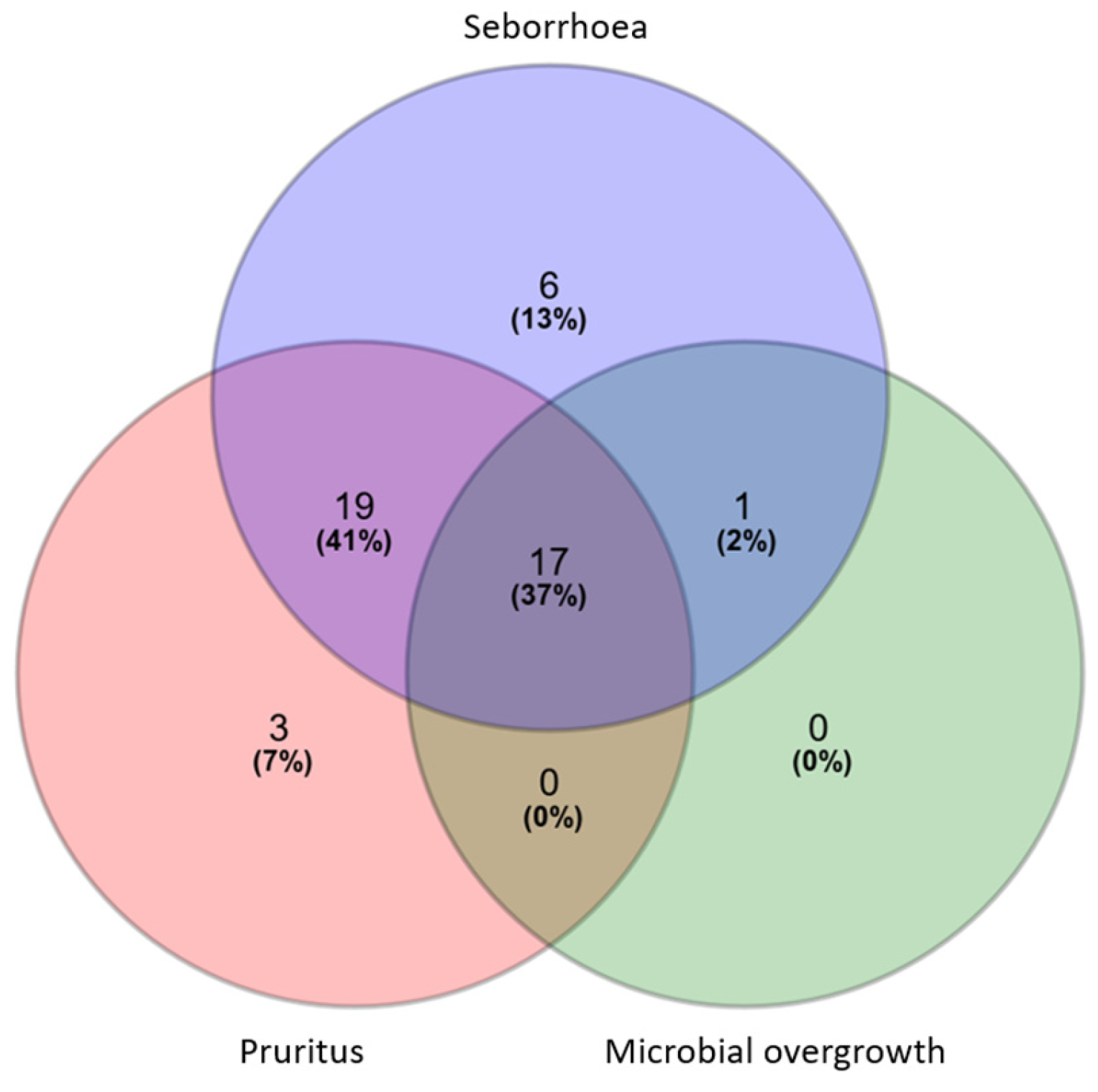
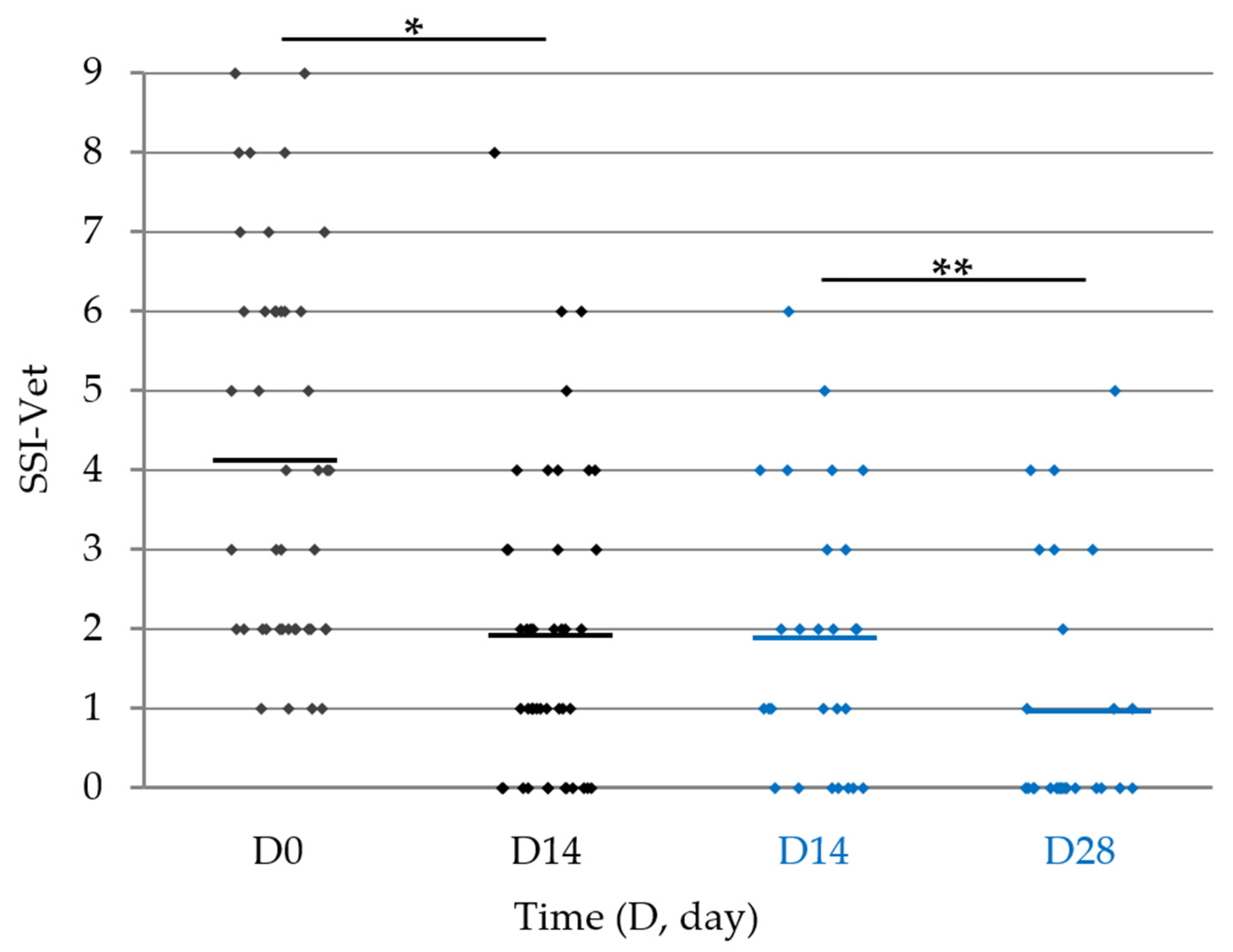
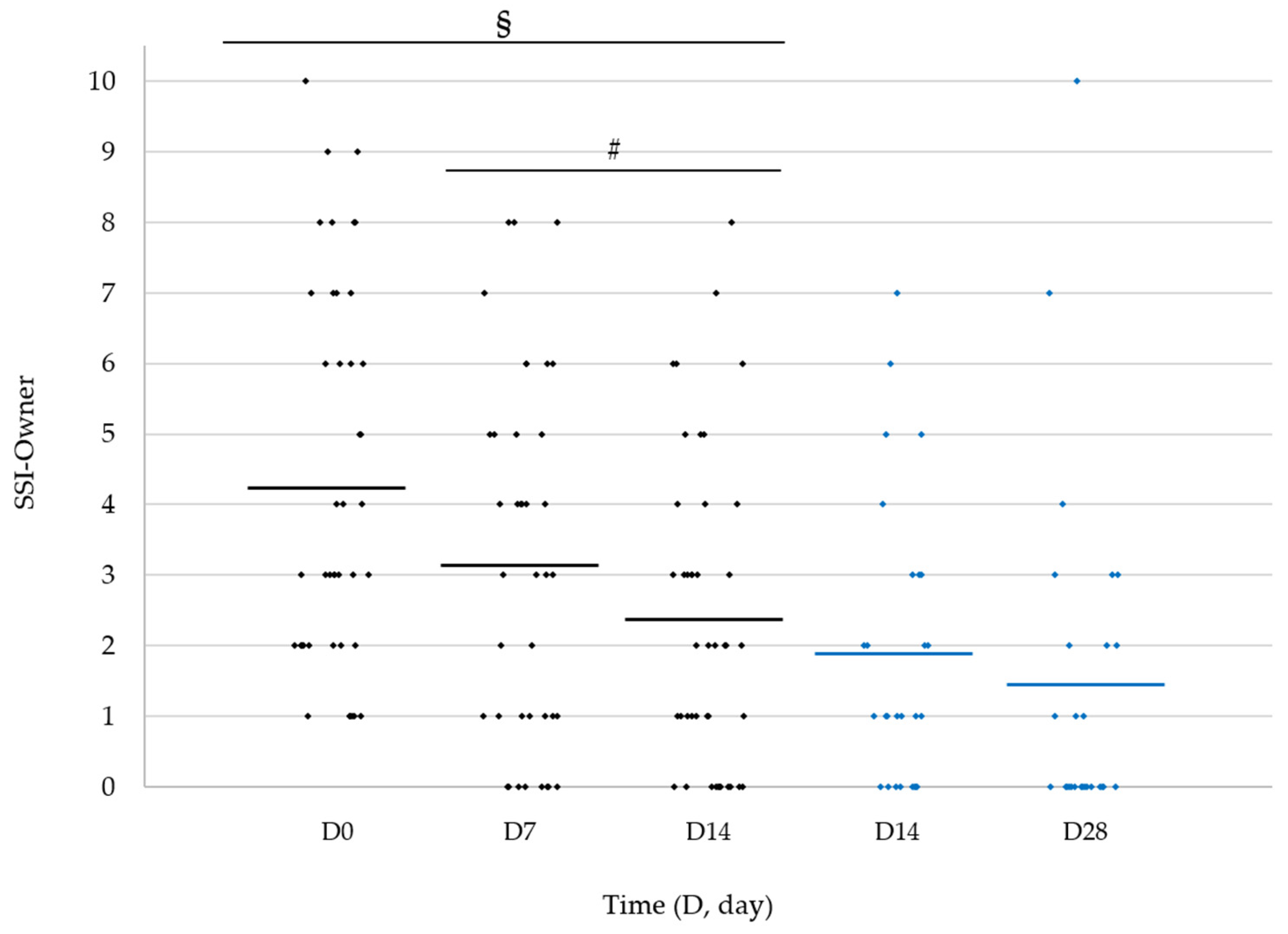
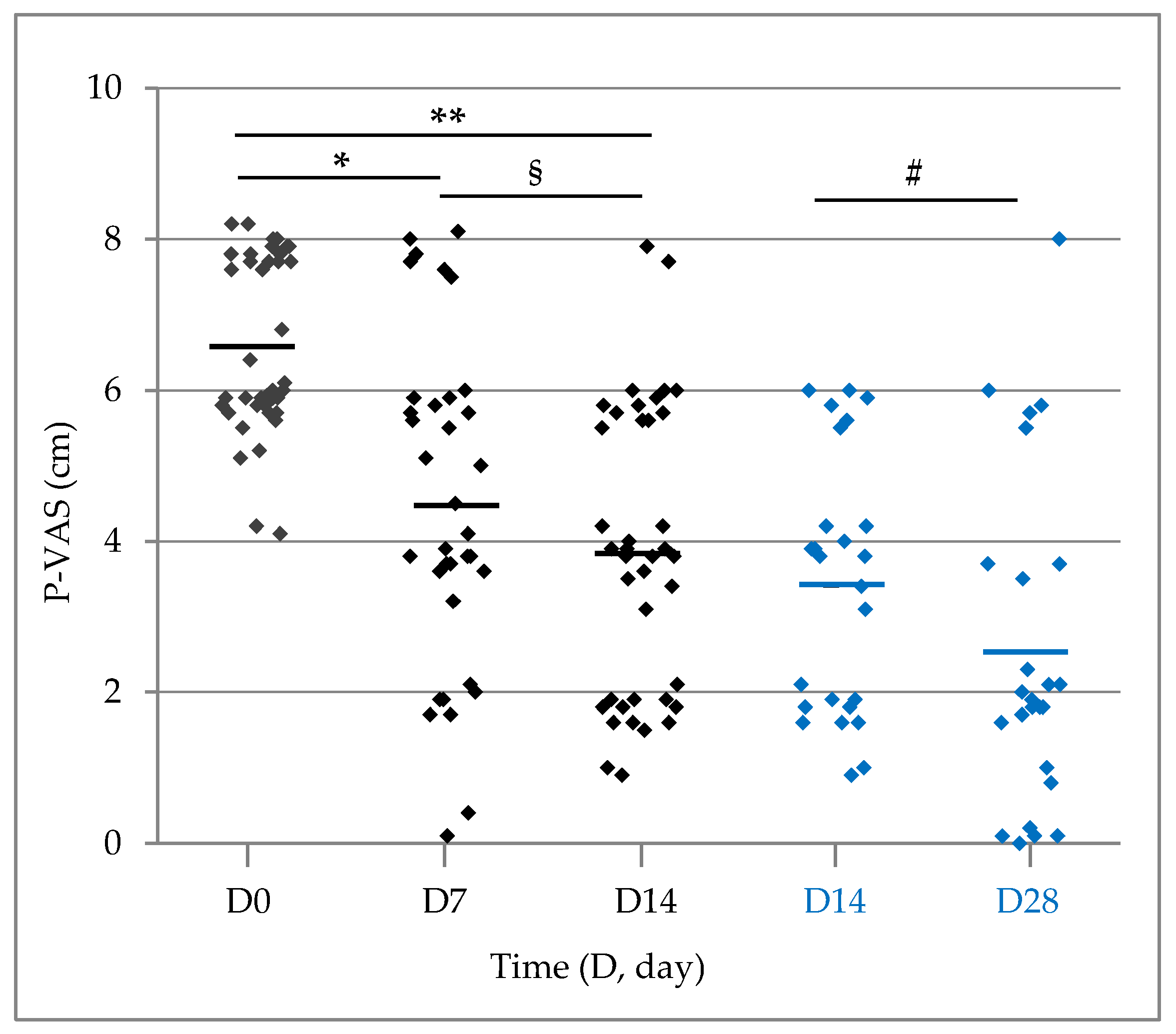
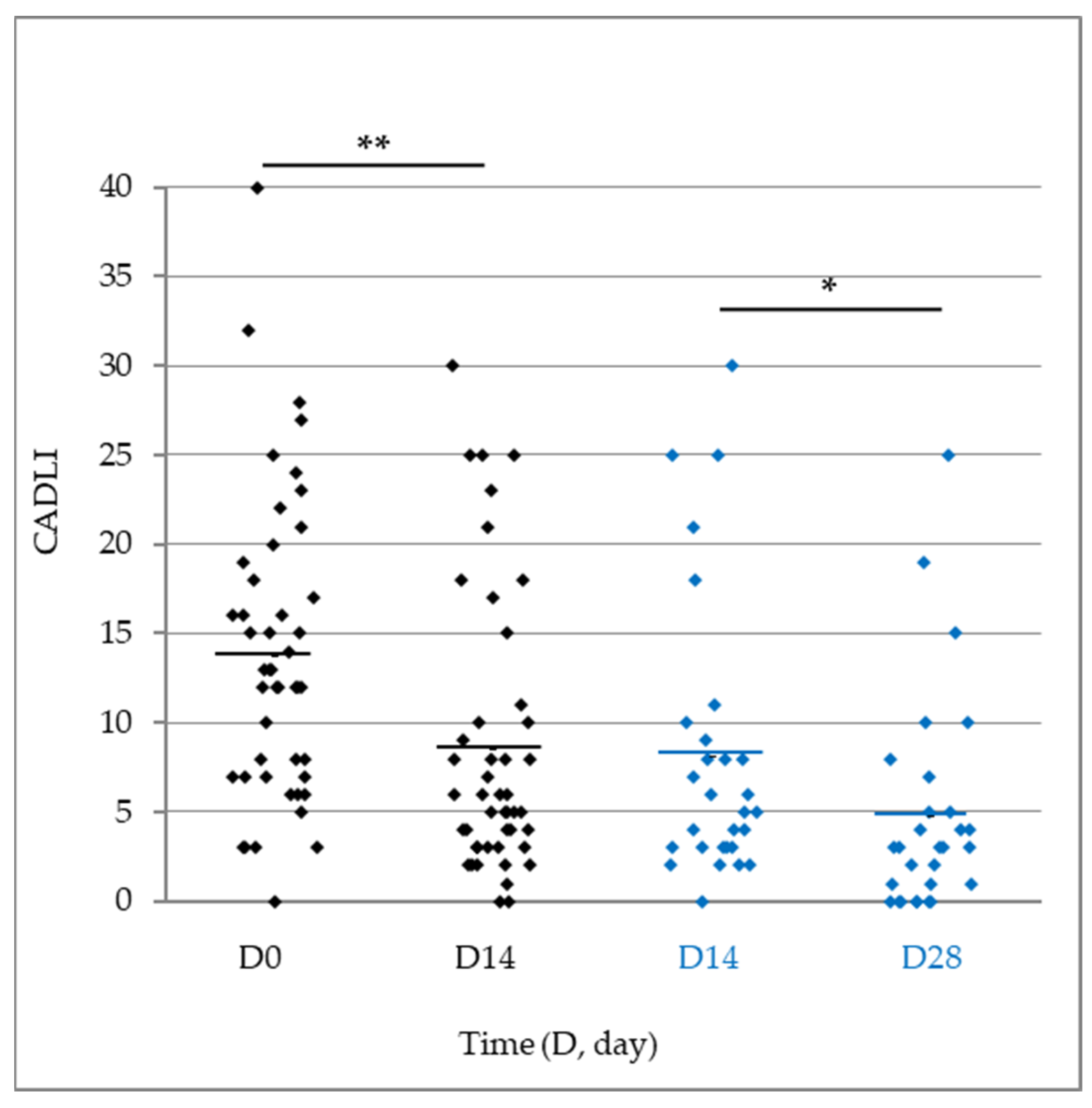
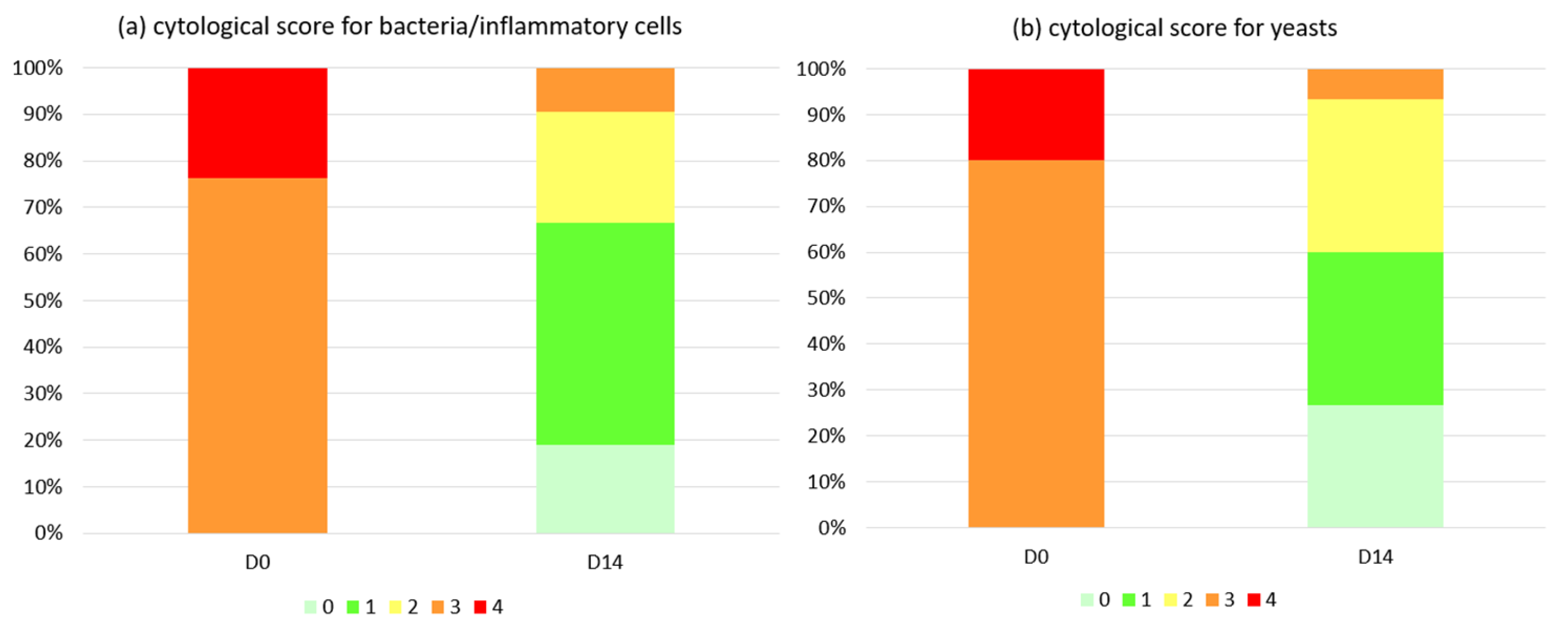
| Inclusion Criteria | Exclusion Criteria |
|---|---|
|
|
| Parameter | 0 | 1 | 2 | 3 |
|---|---|---|---|---|
| Malodour | absent | perceptible in proximity to the animal | perceptible at some distance from the animal | strong even at some distance |
| Scaling | absent | mild | moderate | severe |
| Greasiness | absent | mild | moderate | severe |
| Extent (% of the body surface) | <20% | 20–50% | 50–75% | >75% |
| Allergen-specific immuno- | ||||||
| Injectable | therapy | |||||
| Oral | lokivetmab | 3 | ||||
| treatment | 7 | - | ||||
| Ciclosporin | 3 | 1 | - | |||
| Oclacitinib | 18 | 1 | - | |||
| Oclacitinib + Prednisolone | 1 | - | - | |||
| Total dogs with concurrent therapy | 22 | 9 | 3 | 34/46 (74%) | ||
| D7 | D14 | D28 | |
|---|---|---|---|
| n = 35 | n = 39 | n = 25 | |
| VAS reduction ≥ 2 cm p (vs. previous study time) | 20 (57%) <0.0001 | 30 (77%) 0.0853 | 23 (92%) 0.6671 |
| VAS reduction ≥ 50% p (vs. previous study time) | 9 (26%) 0.0006 | 17 (44%) 0.1448 | 19 (76%) 0.1398 |
| VAS < 2 cm (“normal”) p (vs. previous study time) | 6 (17%) 0.0088 | 12 (31%) 0.1893 | 13 (52%) 0.3931 |
| D0 | D14 | p | D14 | D28 | p | ||
|---|---|---|---|---|---|---|---|
| n = 46 | n = 46 | D14 vs. D0 | n = 29 | n = 29 | D28 vs. D14 | ||
| CADLI (tot) | Mean SE | 13.7 1.24 | 8.5 1.14 | p < 0.0001 | 8.5 1.46 | 4.8 1.12 | p = 0.0011 |
| CADLI 1 | Mean SE | 8.5 0.71 | 5.2 0.62 | p < 0.0001 | 5.2 0.83 | 3.3 0.96 | p = 0.0494 |
| CADLI 2 | Mean SE | 5.2 0.74 | 3.3 0.64 | p = 0.0008 | 3.3 0.75 | 1.4 0.36 | p = 0.0417 |
Disclaimer/Publisher’s Note: The statements, opinions and data contained in all publications are solely those of the individual author(s) and contributor(s) and not of MDPI and/or the editor(s). MDPI and/or the editor(s) disclaim responsibility for any injury to people or property resulting from any ideas, methods, instructions or products referred to in the content. |
© 2024 by the authors. Licensee MDPI, Basel, Switzerland. This article is an open access article distributed under the terms and conditions of the Creative Commons Attribution (CC BY) license (https://creativecommons.org/licenses/by/4.0/).
Share and Cite
Noli, C.; Morelli, G.; della Valle, M.F.; Schievano, C.; Skinalia Clinical Research Group. Effects of a Protocol Combining a Non-Irritating Shampoo and an Adelmidrol-Based Adsorbent Mousse on Seborrhoea and Other Signs and Symptoms Secondary to Canine Atopic Dermatitis: A Multicenter, Open-Label Uncontrolled Clinical Trial. Vet. Sci. 2024, 11, 229. https://doi.org/10.3390/vetsci11060229
Noli C, Morelli G, della Valle MF, Schievano C, Skinalia Clinical Research Group. Effects of a Protocol Combining a Non-Irritating Shampoo and an Adelmidrol-Based Adsorbent Mousse on Seborrhoea and Other Signs and Symptoms Secondary to Canine Atopic Dermatitis: A Multicenter, Open-Label Uncontrolled Clinical Trial. Veterinary Sciences. 2024; 11(6):229. https://doi.org/10.3390/vetsci11060229
Chicago/Turabian StyleNoli, Chiara, Giada Morelli, Maria Federica della Valle, Carlo Schievano, and Skinalia Clinical Research Group. 2024. "Effects of a Protocol Combining a Non-Irritating Shampoo and an Adelmidrol-Based Adsorbent Mousse on Seborrhoea and Other Signs and Symptoms Secondary to Canine Atopic Dermatitis: A Multicenter, Open-Label Uncontrolled Clinical Trial" Veterinary Sciences 11, no. 6: 229. https://doi.org/10.3390/vetsci11060229
APA StyleNoli, C., Morelli, G., della Valle, M. F., Schievano, C., & Skinalia Clinical Research Group. (2024). Effects of a Protocol Combining a Non-Irritating Shampoo and an Adelmidrol-Based Adsorbent Mousse on Seborrhoea and Other Signs and Symptoms Secondary to Canine Atopic Dermatitis: A Multicenter, Open-Label Uncontrolled Clinical Trial. Veterinary Sciences, 11(6), 229. https://doi.org/10.3390/vetsci11060229









